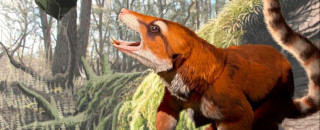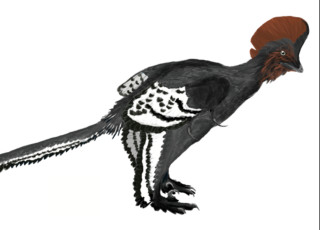Magnificent Utah Beast Lived Under the Feet of Dinosaurs
A restoration of what the early mammal Cifelliodon would have looked like in life. Credit: Jorge A. Gonzalez
By Riley Black
The Mesozoic world wasn’t entirely populated by dinosaurs. Many other organisms flourished alongside the “terrible lizards,” including our ancient mammal ancestors and relatives. They may have been small, but they were as different from each other as flying squirrels, beavers, and badgers are today. An exceptional find from eastern Utah helps underscore that point.
The roughly 125 million-year-old fuzzball is named Cifelliodon wahkermoosuch. Paleontologist Adam Huttenlocker - formerly a University of Utah postdoc and now at the University of Southern California - described the fossil with the help of several collaborators.
“When I first saw the skull of Cifelliodon, I was struck by both its size and how primitive it looked, particularly the narrow brain case and tall sagittal crest,” Huttenlocker says. In other words, the skull looked very ancient compared to related fossil beasts that lived at the same time. But upon analysis, Cifelliodon came to stand out for two reasons.
In the tree of life, Cifelliodon belongs to a group of animals called haramiyidans. These were what paleontologists call “stem mammals” - furry creatures related to the origin of the varied mammals we see around us today. And for its time, Cifelliodon was large.
When alive, Huttenlocker says, Cifelliodon weighed about two pounds. That’s the size of a small hare, making Ciffeliodon one of the largest mammal relatives to live during the Age of Dinosaurs. Despite the stereotype that Mesozoic mammals were all small, shrew-like insect catchers, Huttenlocker says, “Cifelliodon reinforces the recent idea that haramiyidans and other stem mammals were diverse in dietary ecology, life habits, and body size.”
But there was something else. When Huttenlocker and colleagues looked at what other creatures Cifelliodon was related to, they didn’t find its closest connections in ancient North America. Instead, the closest relatives of Cifelliodon lived in the confines of prehistoric Africa.
“The closest anatomical relative of Cifelliodon is a tooth from Morocco whose shape has puzzled paleontologists for decades,” Huttenlocker says, “because it matched no other known mammal from that time.” That tooth, called “Hahnodon,” resembles a tooth in the jaw of Cifelliodon and links the two animals together. This, along with other comparisons, hints that Cifelliodon helps outline how the world’s continents were connected in a different way. “We think that Cifelliodon represents a subgroup that may have dispersed into the southern continents and became fairly successful during the Cretaceous, but became extinct in the Northern Hemisphere shortly after the landmasses separated,” Huttenlocker says.
This discovery alters the timeline of how the continents were connected to each other. “It’s generally thought that the northern and southern continents, as well as Europe and North America, were completely separated by the end of the Jurassic Period 145 million years ago,” Huttenlocker says. But recent fossil discoveries indicate that land bridge connections allowed animals to disperse to different continents for much longer.
“Based on intense fieldwork taking place now in the basal Cretaceous of Utah and in Europe,” Huttenlocker says, “there is evidence of a North Atlantic Land Bridge that may have connected the Old and New Worlds into the Cretaceous.” There appears to be a similar connection between Africa and Europe, as well, meaning that animals were freer to roam far and wide between these continents for much longer. Cifelliodon is now part of that picture, indicating that mammal relatives from the southern hemisphere continents had a way to venture north beyond the end of the Jurassic. Though haramiyidans thrived long before the invention of air travel, they had clearly had their own way of becoming world travelers.
Riley Black is the author of Skeleton Keys, My Beloved Brontosaurus, Prehistoric Predators, and a science writer for the Natural History Museum of Utah, a part of the University of Utah in Salt Lake City. Our mission is to illuminate the natural world and the place of humans within it. In addition to housing outstanding exhibits for the public, NHMU is a research museum. Learn more.


